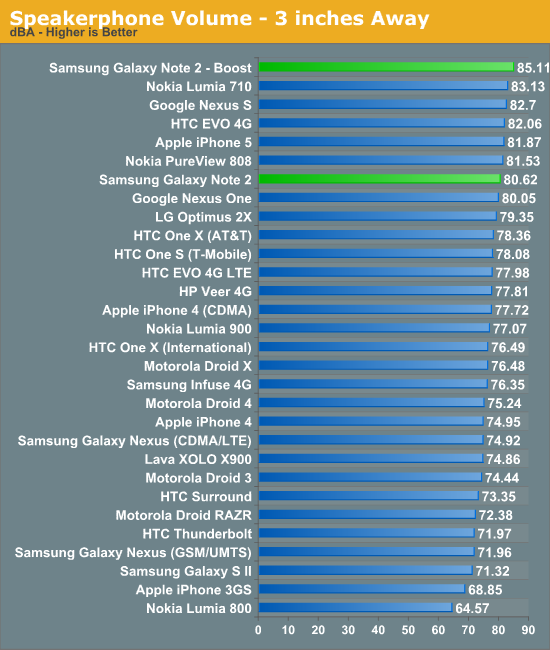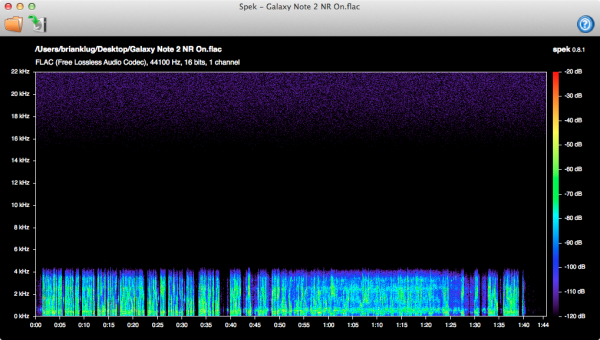Samsung Galaxy Note 2 Review (T-Mobile) - The Phablet Returns
by Brian Klug on October 24, 2012 9:00 AM ESTSpeakerphone
The Note 2 puts its speakerphone in the same place as the original Galaxy Note, and thanks to the large size of the handset I bet there’s plenty of space for a big driver. The Note 2 also includes a new boost mode I didn’t see on Galaxy S 3 before that boosts speakerphone output volume considerably.

The tradeoff is that there is significantly more saturation and clipping with this mode toggled, but it is very, very loud.
Noise Suppression
Samsung has continually included Audience earSmart processors in its handsets for noise rejection and filtering, and the Note 2 is no exception. Both the original Note, and Note 2 include the Audience eS305 voice processor, though the Note 2 includes newer firmware thanks to its later release date. I’m told that both the Note and Note 2 were interesting challenges due to the extreme size of the handset and just how far apart the microphone pair is — there’s one at the very top, one at the very bottom on both models. In addition the T-Mobile Note 2 also has wideband AMR enabled (AMR-WB), which I confirmed inside ServiceMode by poking around. I called between two T-Mobile devices (the Note 2 and my own HTC One S) but it appears as though T-Mobile is still using AMR-NB over UMTS at least as evidenced by the 4 kHz maximum in the below spectral view. Either that or my HTC One S is the limiting factor.
Samsung is unique in that it gives a nice easy way to enable and disable the noise rejection paths by tapping the menu button, so we can easily test with it on and off just to see how much difference it makes. I’ve been supplied an industry standard babble track that emulates a loud cafe or restaurant, complete with a din of voices, doors opening and closing, and background bustle. I’ve found that playing this on loop in my office when I want that cafe vibe mitigates the desire to go and pay exorbitant amounts of money for the luxury of distraction, but I digress.
Galaxy Note 2 - Noise Rejection Enabled by AnandTech
Galaxy Note 2 - Noise Reduction Off by AnandTech
Anyhow I went ahead and tested the Note 2 with the babble track at a very loud maximum loudness of 94 dBA which is likely above spec, but a worst case. You can hear a dramatic difference between the Note 2 with the noise rejection turned on and off. I’ve heard eS305 do even better at rejecting literally all noise on the Xolo X900, but this is our first time using the babble track as opposed to music so my mental comparison isn’t quite fleshed out.











131 Comments
View All Comments
The0ne - Wednesday, October 24, 2012 - link
Don't worry, I'm 40 years old myself and screen specs are very important for me due to my aging eyes. I've since replaced all my LCDs with 30" IPS ones, e-readers and tablets have at least x800 and now this phone if I decide to buy one (if pricing is right).I was glad to read that statement in the review as well. It definitely put a smile onto my face to actually read it and have someone share the perspective. Mind you my eyes aren't too bad being .75 off but it does make a huge difference having a good screen to look at.
jjj - Wednesday, October 24, 2012 - link
Not a fan of the S3 but for some reason i kinda like this one.The weight seems rather high,after all most of the time the phone sits in a pocket,hope they get rid of some layers of glass in future models.Maybe by then we also see Corning's Willow Glass and the flexible Atmel touch sensor (not controller) for a thinner bezel.
It does feel a bit outdated already with quad Krait devices announced and dual core A15 arriving soon hopefully (Gigaom had some numbers for the A15 based Chromebook and they look impressive)
enezneb - Wednesday, October 24, 2012 - link
That 11 million contrast ratio is just amazing; a true testament to the potential of AMOLED.I could forsee Samsung improving their color calibration standards for the next generation of flagships seeing how they're under considerable pressure from the likes of SLCD2 and Apple's retina display. Paired with this new pentile matrix ultra-high ppi displays in the range of 400 may be possible as well (a la SLCD3)
Looks like next year will be another exciting year for mobile display technology once again.
schmitty338 - Wednesday, October 24, 2012 - link
You can change the colour calibration to be more 'natural' in the TouchWiz software ont eh Note II.Also, personally I don't see the need for 'more accurate' colours on a phone. Maybe if you are a pro photog who reviews pics on their phone, but otherwise, I love the colourful pop of AMOLED displays. Even the low res pentile AMOLED of my old galaxy S (original...getting the Note 2 soon) looks great for media. Text, not so much, due to the low res and pentile.
slysly - Wednesday, October 24, 2012 - link
Why would colour accuracy ever not be important? I thought the point of a big phone is to make it easier to consume all sorts of media, from websites to photos to movies. Wouldn't more accurate colours be better for all of these activities? To me, it's a bit like saying, I don't see the need to eat delicious food during lunch, or I don't need to be with a beautiful woman on the weekdays. Why settle for something markedly inferior?Calista - Thursday, October 25, 2012 - link
Is your screen properly colour calibrated? Are your walls painted in a neutral colour to avoid a colour cast? Are your lamps casting a specified type of light and shielded to avoid glare? Do you use high-quality blinds to prevent sunlight?This is only a few of the things to consider when dealing with calibration. And a cellphone is unable to deal with any of them unless it stays in the lab.
So for a cellphone the criteria is:
Is it bright enough?
Does it look pleasing to the eye, overly saturated or not?
PeteH - Thursday, October 25, 2012 - link
Eh, depends what you do with it. I can understand wanting an accurate representation of a photo you're taking.And given the option between an accurate display and a less accurate display (all other things being equal) I think most people would opt for the more accurate option. Note that I'm not saying they would choose it as better visually (people seem to be suckers for over saturated displays).
Zink - Wednesday, October 24, 2012 - link
Great review. Just the right amount of detail and I really like your perspective on day to day use.Mbonus - Wednesday, October 24, 2012 - link
Battery Life Question: I have noticed that since I have started using audio streaming apps my battery has taken quite a hit. I wonder if that could be added to your battery life benchmarks?It might not matter for devices like this where you have a large storage upgrade ability, but some other devices are forcing us to the cloud where streaming matters.
Great and thorough review as always!
Brian Klug - Wednesday, October 24, 2012 - link
So with streaming apps and such, even though the bitrate is low, if they're not very bursty (eg download and fill a big buffer, then wait 30 seconds or minutes, then repeat) they can hold the phone in CELL_DCH on UMTS or the appropriate equivalent on other air interface types, and that's what really burns power. It's time spent in that connected state that really destroys things.This is actually why I do the tethering test as well (which has a streaming audio component), but I'm beholden to whether or not the review unit that I'm sampled is provisioned for tethering or not, which is the real problem.
-Brian